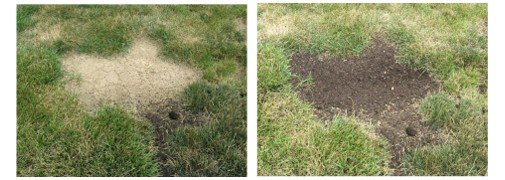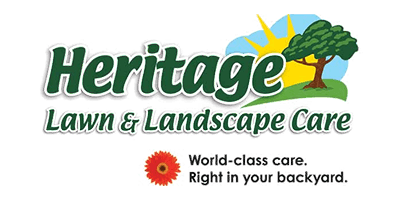Soil consists of decayed minerals (rock) and decayed plants (humus). The most important difference between a healthy growing environment and one that does not support plant or microbe growth is the amount of organic matter or humus. This is really what we mean when we commonly refer to subsoil (usually red or orange in appearance) and topsoil which is a brown or even almost black color due to higher humus content.
Our native soils have a true topsoil layer of up to 12 inches. Organic matter content in the soil has naturally accumulated over the course of time making true topsoil a valuable commodity. This is why the first step in a construction project is usually the removal of this top layer of soil. Most of this topsoil is sold and in most cases a mere inch or so of topsoil (not even that in some cases) is spread onto the surface before establishment of lawns and landscapes.
So as a new home is being constructed and all attention is being focused upon concerns such as paint and carpet and window treatments the last thing on our minds is the amount of topsoil being returned to the property. We can overcome this condition for a while by supplementing synthetic manufactured fertilizers. Increasingly, we are now focusing more attention upon improving the soil environment and decreasing the amount of synthetic input creating a more “sustainable” and environmentally friendly system.
Whether in a forest or in your back yard, a healthy natural environment cleanses the air of pollutants and carbon, cools summer temperatures, captures rainfall and nutrients and continues the process of building the soil and supporting the soil ecosystem. A healthy 50 by 50 foot turf area produces enough oxygen to support a family of four. Healthy turf also prevents soil erosion. The picture above illustrates a thin, inadequate stand of turf that could lose a ton or more of precious topsoil per acre every year.
Soil aeration and organic topdressing along with overseeding as needed are the best options for improving a soil environment. They are often performed together and can actually build soil quality to the point where synthetic additives can eventually be minimized or even eliminated.
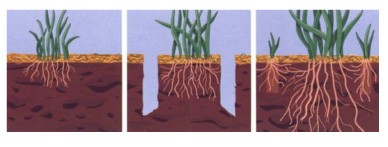
Soil compaction not only restricts root growth, it also prevents overall health of the soil environment. Penetration of air, moisture and roots are all essential. Non-compacted soil will capture rainfall more efficiently allowing less runoff. Plant roots will grow deeper too and the result is a much more drought tolerant lawn.
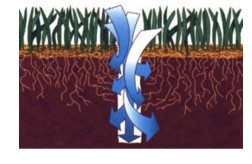
Air exchange is critical too. Not only do plant roots need air but all the microbes that are essential for healthy soil also need air. Imagine soil breathing just as we do. We inhale oxygen-rich fresh air and exhale CO2 and other waste gasses. Soil is full of living organisms that function the same way. The soil breathes when it rains. As rain water percolates down through the soil it displaces gasses as it fills the soil pores (exhale). Then as the water percolates deeper and either evaporates or is taken up by plants the pore space is filled by air that is drawn in (inhale). The distinctive smell after a rain is actually that soil ecosystem exhaling.
Soil becomes compacted mainly due to our activity when we repeatedly walk or drive over the same area. When we allow soil to become compacted then the natural process are restricted and the soil ecosystem suffers. We see the effects first in those areas where traffic is concentrated such as a gateway or a narrow path. But every step we take and every pass with the mower causes compaction.
Core aeration removes “cores” of soil and helps to relieve compaction. We recommend core aeration at least every other year and more frequently if necessary.
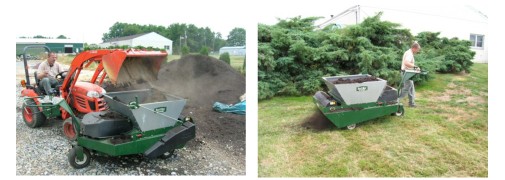
Right, the topdressing machine spreads high-quality organic compost evenly over turf.
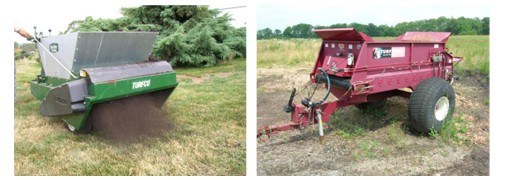
Right, a larger topdressing machine used on sports fields and large lawns.
